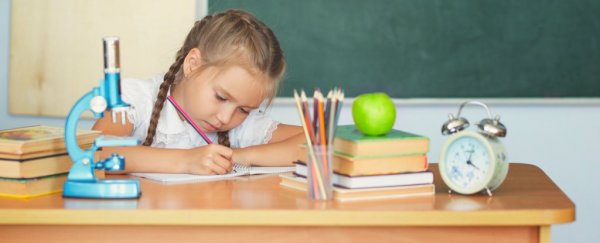Way back in the 1970s, when American children were asked to draw a scientist, less than 1 percent drew a woman. Five decades later, when American children were asked to complete the same task, one in three drew a female, according to new Northwestern University research.
The heart-warming trend suggests that as more women enter the field of science and as more female scientists are featured in the media, the stereotypes associating science predominantly with men have been significantly weakened.
"Given this change in stereotypes, girls in recent years might now develop interests in science more freely than before," said lead author David Miller, a psychology PhD candidate at Northwestern.
"Prior studies have suggested that these gender-science stereotypes could shape girls' interests in science-related activities and careers."
The landmark study is the very first systematic, quantitative review of the "Draw-A-Scientist" literature.
To get a feel for how scientist stereotypes have changed over time, the recent study combined the results of 78 US "Draw-A-Scientist" studies, which included more than 20,000 American children from K through 12.
In the very first study, conducted between 1966 and 1977, less than one percent of nearly 5,000 children drew an image resembling a woman.
Instead, their artwork almost exclusively featured men working in the lab with the classic white lab coat, glasses and gloves.
Yet in studies conducted between 1985 and 2016, it was found that 28 percent of children on average drew a female scientist.
Even better, both girls and boys drew more female scientists over time, although it's true that more young girls drew female scientists than young boys.
"Our results suggest that children's stereotypes change as women's and men's roles change in society," said co-author Alice Eagly.
"Children still draw more male than female scientists in recent studies, but that is expected because women remain a minority in several science fields."
The researchers were also curious to find out exactly when American children begin to form gender stereotypes about scientists.
They found that around 5 years of age, American children drew roughly equal percentages of male and female scientists. But during elementary and middle school, the tendency to draw a male scientist more than a female one began to take hold, and increased strongly with age.
These older children were also much more likely to draw other detailed stereotypes, like the white lab coat and glasses.
The results suggests that science stereotypes are learned with age and develop with the children as they mature.
"These changes across children's age likely reflect that children's exposure to male scientists accumulates during development, even in recent years," said David Uttal, another co-author of the study.
The good news? If these stereotypes are learned through observation, they can also be changed through observation.
"To build on cultural changes, teachers and parents should present children with multiple examples of female and male scientists across many contexts such as science courses, television shows and informal conversations," Uttal said.
The study was published by Northwestern University.
This article was originally published by Science As Fact.
Science As Fact is our sister site where we cover politics, debunking, fact checking, and humour. If you want more like this, head over to Science As Fact.
